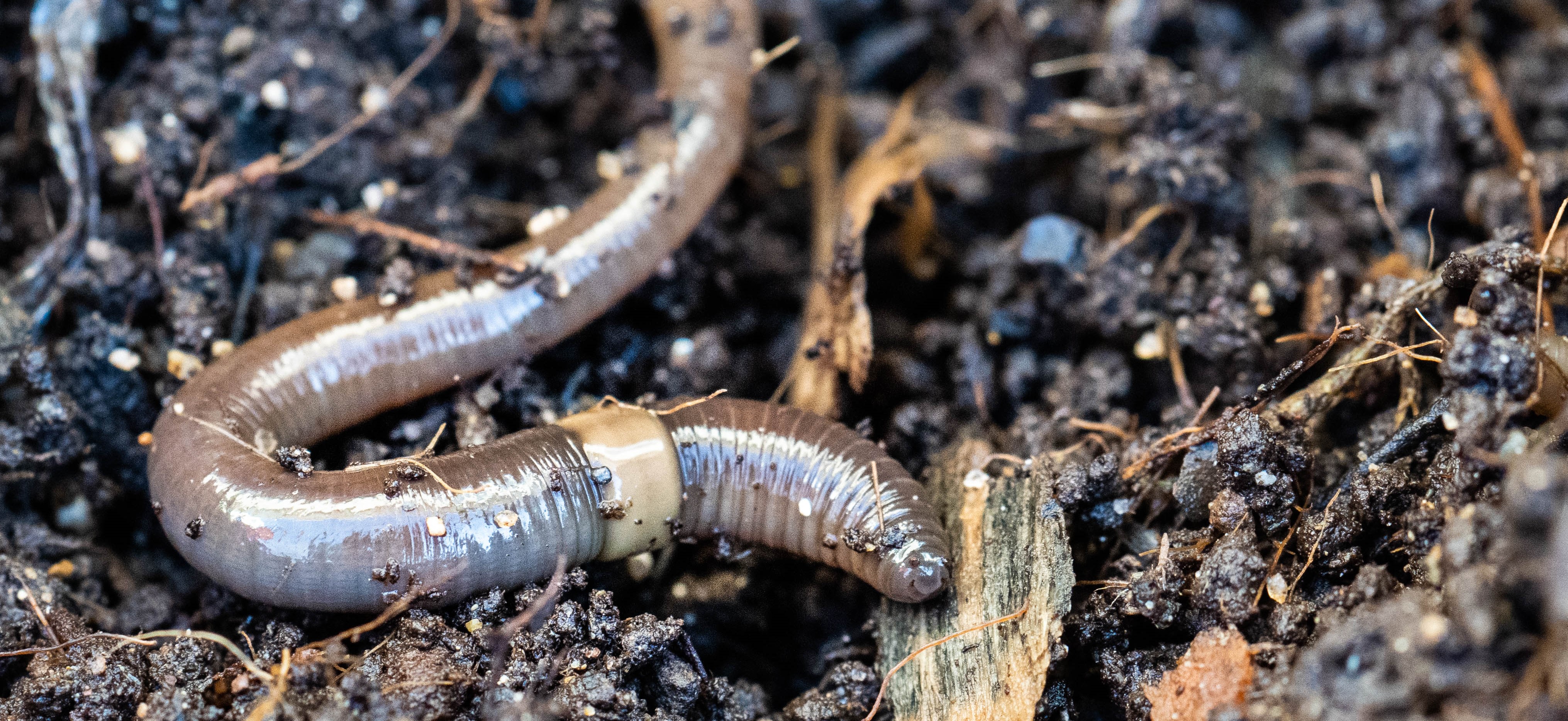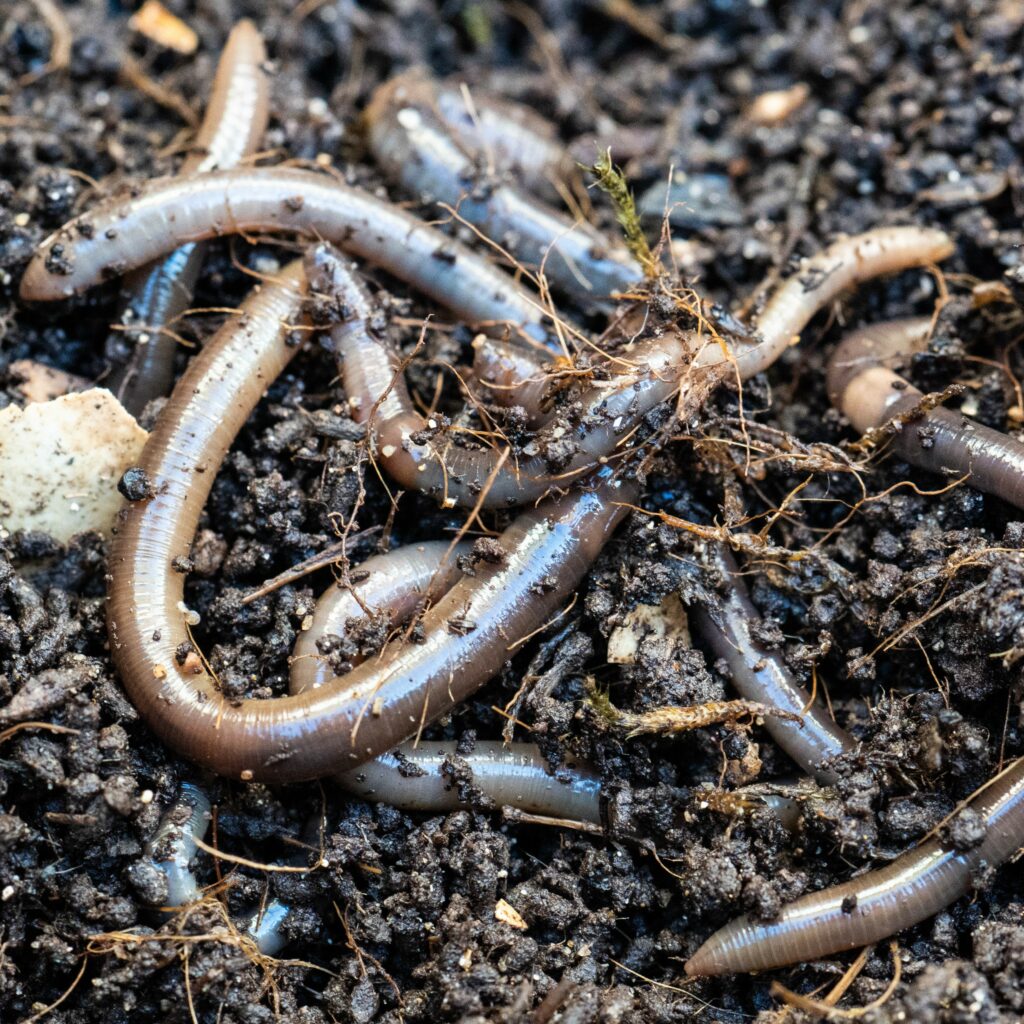| Scientific name: | There are 16 species of pheretimoid (“jumping”) worms recorded in North America. The three most invasive species are Amynthas agrestis, Amynthas tokioensis, and Metaphire hilgendorfi.1 |
| French name: | Le ver sauteur |
| Common name(s): | Jumping worms, crazy worms, snake worms1,2,3,4 |

Description:
Jumping worms are smooth, glossy gray or brown earthworms that are known for their erratic, thrashing movement and jumping behavior when disturbed.3,4,5,6,7 Adult jumping worms have a pale, smooth ring that encircles their body.5,6,7 This ring is reproductive tissue called a clitellum and can be used to distinguish jumping worms from other earthworms, whose clitellum forms a raised saddle shape, rather than encircling the full body. At 7-16 centimetres in length, adult jumping worms also tend to be larger than most other earthworms.2 In addition, they grow more quickly and can live in higher densities than other earthworms.
Introduction and spread:
Jumping worms are originally from East and Southeast Asia. The species that are now spreading in Canada were first found in North America in the 1900s.1
Jumping worms spread through human activities that inadvertently move adults or eggs.2 These activities include transportation of cargo or goods, movement of potting soil or plants, use as fishing bait, or outdoor recreation.4,6,7

Distribution:
There are over 1000 species of jumping worms, but so far only 16 have been reported in North America.1 The first North American observation of a jumping worm was in California in 1866. The three most invasive species, Amynthas agrestis, Amynthas tokioensis, and Metaphire hilgendorfi, were first observed in the 1930s and 1940s in Maryland, New York, and New York, respectively. Jumping worms are now found throughout the southern and eastern United States and into Canada. As of 2022, Canadian observations of jumping worms are from Ontario, New Brunswick, and Nova Scotia.
Jumping worms can be found in forests, parks, backyards, greenhouses, and compost piles.1
Impacts:
Jumping worms can rapidly change soil properties (e.g., water retention, nutrient cycling) by consuming organic material and producing castings (i.e., feces) that look like coarse coffee grounds.1,5 These alterations in soil structure make it difficult for many plants to grow and negatively impact other organisms in the ecosystem like birds, millipedes and salamanders.1,2,5
Behaviour & Ecology:
Jumping worms have an annual life cycle. They reproduce asexually (in a process known as ‘parthenogenesis’) and produce poppy-seed-sized eggs (known as cocoons).2,5 Cocoons survive over winter and hatch in the spring. Juvenile earthworms then grow to maturity in 2-3 months, at which point they reproduce before dying in the fall.
Management Actions:
You can help prevent the spread of jumping worms in Canada:
- Observe and report. Learn to identify jumping worms (see above description) and report any that you find. Visit www. reportcanadainvasives.ca to learn how to report your sighting.
- Don’t buy or use jumping worms for bait, compost, or gardening. Jumping worms are popular as bait due to their erratic movements. Do not purchase bait sold as Jumping Worms, Asian Jumping Worms, Crazy Worms, Alabama Jumpers, or Snake Worms.6
- Check new soil, compost, mulch, and plants for jumping worms. Look for the worms themselves as well as their castings that look like coffee grounds. If you suspect or find an infestation, dispose of contaminated soil in plastic bags in the garbage, destroy worms by freezing them, and rinse the roots of plants.5
If you’re in an area infested with jumping worms, you can help manage the invasion:
- Don’t share soil, compost, or mulch from an area with a known infestation.
- Increase soil temperatures.6 Jumping worms cannot survive temperatures above 40°C. You can increase soil temperatures by tarping sections of soil or compost that are in direct sunlight. If necessary, you can place soil in plastic bins to move it to a sunlit area.
References
- Chang, Bartz, Brown, Callaham, Cameron, Dávalos, Dobson, Görres, Herrick, Ikeda, James, Johnston, McCay, McHugh, Minamiya, Nouri-Aiin, Novo, Ortiz-Pachar, Pinder, … Szlavecz. (2021). The second wave of earthworm invasions in North America: biology, environmental impacts, management and control of invasive jumping worms. Biological Invasions, 23(11), 3291–3322. https://doi.org/10.1007/s10530-021-02598-1
- O’Keefe, K., & McCulloh, K. A. (2020). Do invasive jumping worms impact sugar maple (Acer saccharum) water-use dynamics in a Central Hardwoods forest? Biological Invasions, 23(1), 129–141. https://doi.org/10.1007/s10530-020-02360-z
- Qiu, J., & Turner, M. G. (2016). Effects of non-native Asian earthworm invasion on temperate forest and prairie soils in the Midwestern US. Biological Invasions, 19(1), 73–88. https://doi.org/10.1007/s10530-016-1264-5
- Cornell University Cooperative Extension. 2017. Invasive Species: Jumping worms. Available at:http://ccecolumbiagreene.org/resources/
- Jumping worm Outreach, Research, & Management Working Group. (2021). Invasive species for homeowners: Asian jumping worms. Available at: http://www.nyisri.org/research/jworm-2/
- Oregon Sea Grant. (2021). Jumping worms: A guide to identifying a new invasive species in the PNW. 18 pp. Available at: https://seagrant.oregonstate.edu/
- Oregon Sea Grant & Oregon State Extension. (2017). The Asian jumping worm (Amynthas spp.). Available at: https://seagrant.oregonstate.edu/
- Maddi, E. L. (2019). Asian jumping worm (Megascolecidae) impacts on physical and biological characteristics of turfgrass ecosystems. Honors thesis, Colby College.

